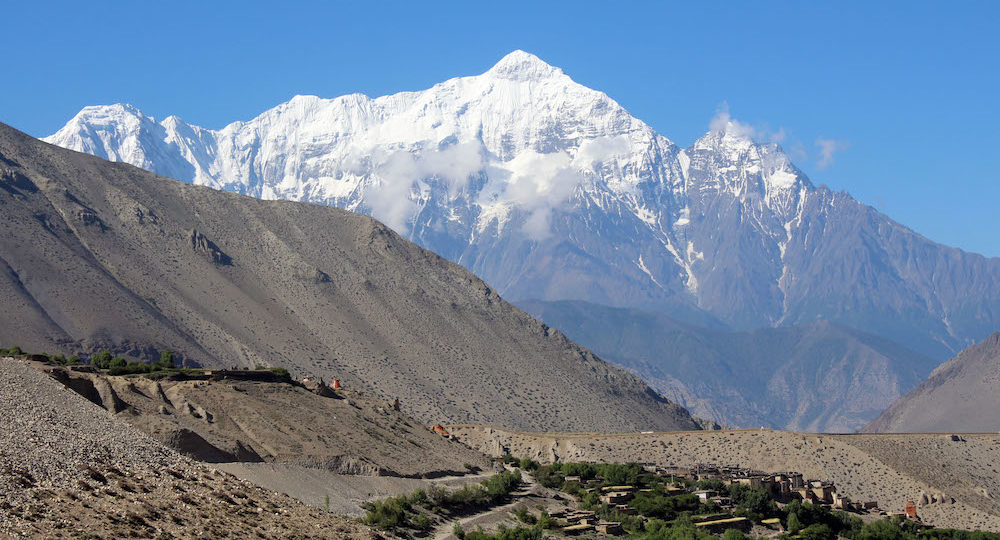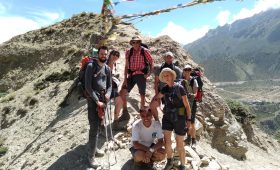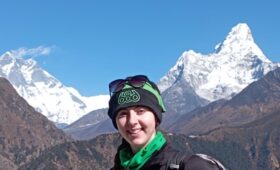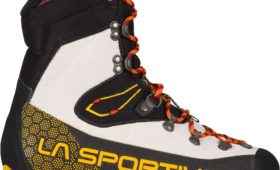Trekking in Nepal can be done all year round. Summer or monsoon seasons for trekking in Nepal are the off-season. Nevertheless, trekking in Nepal in July also offers some fantastic short and long trekking.
July is the month of transition between summer and the monsoon season in Nepal, which can get very hot, very humid and very wet. You’ll be lucky to have views of this kind along the Annapurna Circuit during hot and humid weather in July, heavy monsoon weather and thunderstorms are highly likely.
July is one of Nepal’s least popular trekking months. If your trek runs from June to July, you will need to bring good rain gear and light clothing because of the hot humidity and be prepared for heavy monsoon downpours. At 2,000 m, daytime temperatures of 30+ degrees and night time temperatures of about 19 degrees are expected for the most part.
Not surprisingly, the monsoon months between June and August do not attract hordes of trekkers to Nepal. Most people foresee high temperatures, heavy rains that wash bridges and turn roads and paths into boundless “slip-n-slides,” frequent delays in transport, elusive views of the mountains and abundant leeches.
Fortunately, Nepal in July some of the routes for the summer wanderer lie in the rain-shadow, a dry area on the leeward side of a mountainous area that blocks the passage of weather systems producing rain. Although favorable forecasts are not 100% guaranteed, they generally receive much less rain.
We’ve prepared a list of treks to help you plan your summer trek in Nepal to ensure drier feet and sunny dispositions.
Highly Recommended Treks during July
1. Upper Mustang Trek in July
The relative isolation of Mustang from the outside world has contributed to the preservation of Tibetan culture and untouched nature. The high-altitude arid lands of Mustang create a sharp contrast to the lushness of the monsoon on the south side of the rain shadow.
The Upper Mustang Trek leads to the top of 4,000m mountain passes through the bottom of the world’s deepest gorge, the Kali Gandaki gorge and for trekking in Nepal in July, this is a highly recommended trek.
It snakes through sparsely dispersed Buddhist villages, along the edge of steep canyon walls, past hidden caves and red-walled monasteries, with a dramatic backdrop of 8,000 m high peaks. One of the highlights of this trek is reaching Lo Manthang’s forbidden kingdom, one of the last examples of Tibetan culture.
Although the trek itself is going to be relatively dry, it is difficult to get there. The heavy rains in July can make the road to Jomsom’s trailhead impassable and weather delays caused by strong winds, rain and cloud cover can affect flights. If you have time to add some travel and budget buffer days (approximately $300 return trip), flights are usually the best option for this season and region.
Quick Facts
- Duration: 12 – 14 days
- Max. elevation: 4000m.
- Start/Finish: Jomsom/Jomsom
- Difficulty: Moderate
- Accommodation: Lodge
2. Annapurna Circuit Trek
Most of the trekking region is wet during the summer season, but Annapurna Circuit can be done in July due to less rain and not touchable by the weather of Cherapunji behind the rim of Annapurna Himalayas and near Tibet.
The Annapurna Circuit is the best opportunity for the summer trek, the real diversification of Nepal, the geographical climate, the green vegetation; the rapid snow melts the Marsyangdi River and more local people for farming in the villages. Enjoy a trek in the traffic of less trekkers to green valley lands and the view of waterfalls.
For monsoon time, Thorong La Pass is more accessible, while on the top of 5,416m. less snow. Elevation pass, but anyone can have altitude sickness due to high passes. Horse is also available at Thorong la high camp and base camp. If in-case altitude problem for the passes inform your guide and a quick guide arranges a pony for the pass, the scenery is different than Marsyandi valley after Thorong La pass.
The valley of Marsyangdi is greener, and the valley of Kali Gandaki-Jomsom is drier. Due to the unique geography of Nepal’s Tibetan climate, the weather is favorable in this area for trekking in Nepal in July.
Trekking in monsoon time is a blessing for the beauty of the Annapurna Circuit’s high peak filming Himalayas, photography, flowering meadows, lush vegetation.
More greenery is Marsyangdi valley, and Kali Gandaki-Jomsom valley is the more dries valley. The weather in this area is favourable due to the unique geography connecting Nepal’s Tibet landscape climate.
The rest of the trekking area is usually clear from morning until afternoon and it can rain, cloudy, but all the hills are alive with flowering wildflowers such as magnolia and other colorful wildflowers and spectacular views of the snow-capped mountain range.
Quick Facts
- Duration: 10 – 14 days
- Max. elevation: 5416m.
- Start/Finish: Beshisahar/Jomsom
- Difficulty: Moderate to Challenging
- Accommodation: Lodge
3. Nar Phu Valley Trek
Nar Phu Valley Trek takes you to one of Nepal’s most distant and fascinating regions. In recent years, a newly opened region for trekking is similar to the landscapes of Tibet. A rough and wild trek, this trek will take you to the exotic Nar Phu Valley in the Annapurna region’s remote corner.
The Nar Phu Valley is a trek combining remote Nar and Phu villages, narrow canyons, beautiful forests, stunning rock formations, yaks, monasteries, Kang La Pass and unique Himalayan cultures.
This exotic land, visited by very few trekkers, offers an undisturbed form of medieval Tibetan culture, dramatic mountain views and great alpine scenery. Nar Phu Valley trekking starts from Chamje on the same trail as Annapurna Circuit trekking after a 9-hour drive from Kathmandu.
After arriving at Koto, we cross the bridge over the Marshyangdi River to the steep portals of the Nar Phu Valley, which can be easily missed, but although the entrance is narrow and forested, the valley system above opens up to a vast expanse of high snow-peaks, ancient villages and high-altitude settlements.
The pass of Kang La (5315 m) is incredible. Enjoy the view of the mountains such as Annapurna II, Gangapurna, Tilicho peak and then head for Annapurna circuit trek towards Manang.
Manang village (3500 m) marks the start of the next stage. We can drive back to Kathmandu via public transport while returning from Manang to Chame. We can also continue to Jomsom via Thorong La Pass if we have time in our hands.
Quick Facts
- Duration: 10 – 14 days
- Max. elevation: 5315m.
- Start/Finish: Koto/Manang
- Difficulty: Moderate to Demanding
- Accommodation: Lodge
4. Mardi Himal Trek in July
Mardi Himal Trek has an overwhelming adventure blessing the trekkers. You’ll love the enticing views of the Annapurna region’s snow-capped peaks. You’ll have the most beautiful memories walking across the chain of green hills.
The scenic natural beauty of the region is immensely dispersed. It is truly blissful to walk past the traditional Gurung villages and witness Buddhist culture. It is remarkable the warm hospitality of villagers in villages such as Kande, Pothana, Siding, Deurali, etc.
This is the period of the monsoon and the annual rainfall. Less popular Nepal hiking season. Leeches will be fortunate, rain storm will raise its level significantly. Leeches are very sharp in the initial wooded sections. So, at this time of year, better put on long trekking pants before traveling Mardi Himal.
This beautiful journey takes you to 4,500m to show off the beautiful landscapes. Such amazing places to be, here at are the Low Camp, Forest Camp, High Camp, and Mardi Himal Base Camp.
Get ready to remember the Annapurna region’s diverse culture and geography in less time.
Quick Facts
- Duration: 6 – 10 days
- Max. elevation: 4500m.
- Start/Finish: Kande/Phedi
- Difficulty: Easy
- Accommodation: Lodge
Tips for trekking in Nepal in July
Keep the weather conditions up to date. The weather continues to change, particularly in the Himalayas. So, you have to act wisely while trekking in Nepal in July.
Choose your destinations for trekking carefully. If you’re wisely choosing the trekking destinations, July can be one of Nepal’s best trekking times.
Keep yourself updated with the weather conditions. The weather, especially in the Himalayas, keep changing. So, while trekking in Nepal in July, you need to act wisely.
Choose your trekking destinations carefully. If you choose the trekking destinations wisely, then July can be one of the best times to trek in Nepal.
Keep in your trekking packages a few buffer days. It’s mostly unpredictable in the Himalayas since the weather. Therefore, it is wise to set two or three extra days during the trek in case something is inevitable (landslides / floods).
Beware on the Mardi Himal trail of leeches. One of the biggest issues during the month of monsoon is leeches. So, be ready for it. While you’re trekking, you can carry some salt. Wear long hiking pants, long sleeves, long socks and wear ankle trekking boots to avoid getting into your skin.
Other major problems are the mosquitoes and other bugs during the rainy months. Therefore, carrying an insect repellent with you during the trek is essential.
Final Say
There are some who completely avoid trekking in July. However, if you keep an eye on the weather forecasts and prepare your trek accordingly, you can complete any trekking in July in Nepal.
July trekking in the monsoon in Nepal can be one of the most adventurous treks you can do 🙂. If you require more information or have any questions, please contact us.






